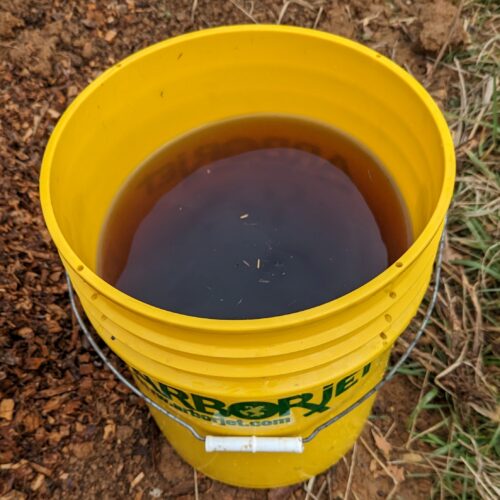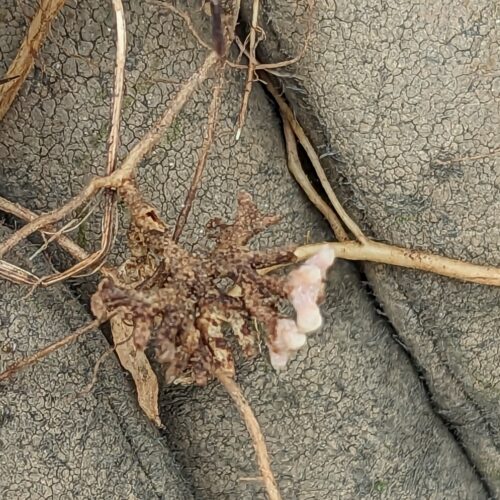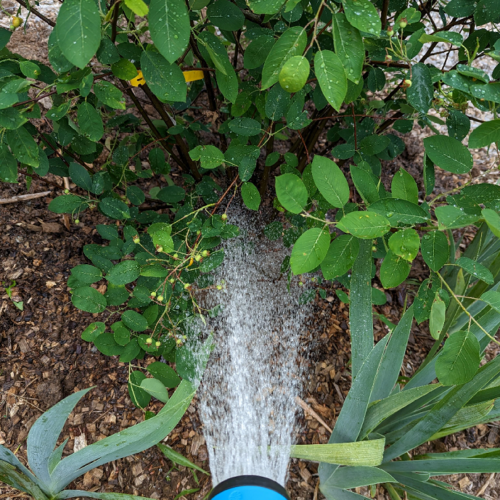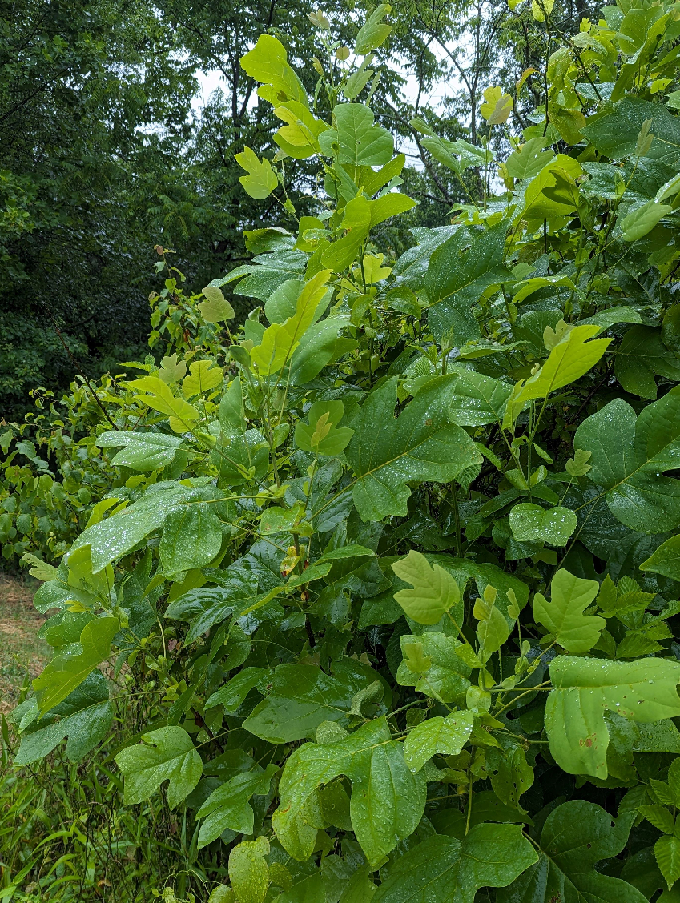To grow and keep plants healthy, we need to consider the soil environment. The soil-root interface is called the rhizosphere. In this section, we will discuss soil health as it relates to plant health.
Plant & Soil Health
A plants requirement for healthy growth takes into consideration: (1) its’ adaptability to site, (2) its’ stage of development, and (3) its environment
- Plant adaptability – encompasses a species inherent resistance to environmental stress and competition
- Stage of development – seed, seedling, cutting, transplant, established, or senescent
- Environment & suitability to site – encompasses cold hardiness, soil (pH, texture, and structure), light, moisture and beneficial microbes.
The best adapted plants are those native to a region. Landscape (nursery, horticultural) plants may or may not always be the best adapted. Many horticultural plants are often non-native, horticultural selections, or hybrids. Many are bred for aesthetics, size, and/or disease resistance.
Changes in climate presents real challenges to increasing plant success through its stages of development.
Soils
- Texture is defined by aggregate size, sand, silt, and clay (i.e., coarse to fine)
- Structure is defined by how soil particles are arranged or aggregated
- Soil pH is determined by the parent mineral(s)
- Microbial component of soils is related to pH and vegetation type
Soil Texture
- Texture is defined by aggregate size, sand, silt, and clay (i.e., coarse to fine)
Soil textures are categorized by the percentages of sand, silt & clay. Loam soils for example are 50 to 75% sand, 75 to 95% silt and 10 to 25% clay. The differing soil types based on the percent sand, silt and clay maybe found online as the soil textural triangle.
- Soils high in sand have excellent aeration and drainage, but are poor in water retention and nutrient holding capacity.
- Soils high in clay have excellent water and nutrient holding capacity, but are poor in aeration and drainage.
A method of mitigating the extremes in soil type is to amend soils to improve aeration, drainage, water infiltration and nutrient holding. The addition of organic matter such as compost or biochar are two good approaches. Add compost as a top dressing to beds annually. Doing so, in the fall months is ideal and consistent with the natural accumulation of organic matter (as with leaf fall).
Supplemental to the organic matter additions, soil conditioners such as Arborjet | Ecologel’s EnviroPlex, a liquid humic acid source will help to increase the humic value without added nitrogen. This means that it is an ideal summer or in season amendment. Additionally, EnviroPlex may be tank mixed with CytoGro or SeaXtra, sources of cytokinins which aids in plant root development.

Humic and Organic Acids
EnviroPlex is a unique, liquid organic soil conditioner produced from a humate extraction process. EnviroPlex contains 22% humic acids derived from leonardite ore. Humic acids have the ability to hold positively charged ions such as potassium, calcium, magnesium, iron, and manganese, as well as several other metal nutrients. This allows EnviroPlex to chelate nutrients and increase their plant availability. The carbon content in EnviroPlex helps to stimulate and support soil microbial activity. Soil microbial activity is essential to nutrient cycling, particularly beneficial in sandy or poor soils. Humates have also been shown to mimic the effect of plant hormones, particularly cytokinins and auxins, which promote greater rooting, important for plant establishment.
CytoGro® is an EPA registered bio-stimulant derived from seaweed extracts. A consistent source of cytokinins and auxins, CytoGro stimulates root growth, increases tree vigor; and improves stress tolerance. CytoGro contains cofactors, such as amino acids, and minerals, which are effective at increasing root mass, water and fertilizer uptake.
Soil Aggregation
- Structure is defined by how soil particles are aggregated
Soil texture relates to particulate sizes, soil aggregation is how they are arranged. Soil fines (clay) may be viewed as the “glue” in soils. Organic matter also glues particles to form clusters or aggregates.
In natural soil profiles, the parent material (rock, “C” horizon) weathers to become subsoil (“B” horizon). The topmost or most weathered soil is the “A” horizon. Overlying the A horizon is an organic layer derived from fallen leaves, herbaceous and woody parts shed by trees and understory plants. This organic layer is the “O” horizon.
Much of our landscapes no longer have this layered soil profile. Rather they are often stripped of organic matter during construction or by the removal of organic matter (grass, leaves).
Well-structured soils are comprised of mixed particle sizes organized in a manner that allows water to infiltrate and percolate through the surface layers. They hold moisture for root absorption, but are sufficiently permeable to allow for internal drainage.
In addition to holding moisture, a well-structured soil allows for gas exchange, that is O2 is allowed in, and CO2 passes out. Roots respire CO2, and absorb O2 to function normally. Well-structured soils have good porosity.
In disturbed soils, and soils that have been subject to compaction, water infiltration and gas exchange may be severely limited, affecting root health and function. Compacted soils have poor porosity leading to poor root development.
The negative effects from stripped, compacted soils may be mitigated using soil amendments. Where appropriate, organic matter may be replaced using wood chips. In beds that are newly amended, compost or biochar may be incorporated. Generally, the additions of compost and mulches are made once annually.
However, in established landscapes, liquid amendments may be more useful. For example, soil injection or drench of EnviroPlex adds organic and humic acids to the soil. Other amendments and soil conditioners include CytoGro (50 ppm cytokinins) and Bio MP (5-3-2), which adds carbohydrates to invigorate beneficial soil microbes. These amendments can be added monthly throughout the growing season.
Soil pH and Mineral Availability
- Soil pH is determined by parent material and moisture
Plants require essential minerals for their basic life processes (metabolism, growth, reproduction, etc.). These minerals include nitrogen, phosphorous, potassium, calcium, magnesium, sulfur (macro-nutrients), iron, manganese, boron, copper, zinc and molybdenum (micro-nutrients). They also require carbon (as CO2) and water for photosynthesis.
Plant available minerals are those that are in the soil solution, typically in an ionized form. However, their bio-availability is dependent upon soil pH. pH is a measure of hydrogen ion concentration in solution. The pH scale is logarithmic, that is each point of the pH scale represents a 10-fold change in acidity. The pH scale ranges from 0 to 14, where a pH of 7 is neutral. A pH <7.0 is acidic (greater number of hydrogen, H+ ions), and pH >7.0 is considered alkaline (greater number of hydroxyl, OH–, ions). Most soil minerals are available in soils with a pH of 6.0 to 6.5. Below a pH of 6.0, Ca++ and Mg++ ions are less available, whereas in soils with pH’s greater than 7.0, many of the metal cations (Iron, manganese, zinc, boron, copper) and phosphorous are less plant available.
Refer to online charts of soil pH and mineral availability for an illustration.
Moisture and pH
In maritime (coastal) environments, precipitation exceeds evaporation, which results in leaching of cations. Ca++ and Mg++ ions are readily leached in such conditions. These soils tend toward increased acidity.
In continental (interior) environments, evaporation exceeds precipitation, which results in the upward movement of cations. In these conditions, Ca++ & Mg++ ions move upward in the soil profile. These soils tend to have greater alkalinity.
Soil Microbes
- Microbial component of soils is related to pH and vegetation type
Many trees are adapted to maritime conditions, where soils tend to be acidic (pH <6.0). The microbes best adapted to these conditions are the fungi. Fungi may be saprophytic, parasitic or symbiotic. Saprophytes are the decomposers, parasites are disease causing, and symbiotic fungi are mycorrhizal. Mycorrhizae (literally “fungal root”) occur as ecto- or endo-phytes (Ecto- meaning outside). These fungi form a network or reticulum around the root (Endo- meaning inside). These fungi grow within the plants’ roots. Oaks and pines are obligate for ecto-mycorrhizae. Other species, such as maples have endo-mycorrhizal associations. Even others, the legumes, have bacterial associates known as rhizobia (root nodules with nitrogen-fixing bacteria).
Grasses and Forbs are generally adapted to continental environments, where soils tend to be basic (pH >7.0). The microbes best adapted to these conditions are the bacteria. Soil bacteria are critical to nitrogen cycling.

The Nitrogen Cycle
Nitrogen fixing bacteria utilize atmospheric nitrogen (N2) and “fix” it to ammonia (NH3). Nitrifying bacteria convert ammonia to NO3– (nitrate). Both nitrate and ammonium (NH4+) can be utilized by plants. Denitrifyng bacteria convert plant available N back to N2 where it dissipates back into the atmosphere.
The Carbon Cycle
CO2 is utilized by plants for photosynthesis. Animal respiration and the end product of combustion results in the production of CO2. Dead plants and animals decay adding organic matter (carbon) to the soil.
Carbon: Nitrogen Balance
Living organisms are made up of 16 essential minerals including carbon, hydrogen, oxygen, nitrogen, phosphorous, potassium (as well as S, Ca, Mg, Fe, Mn, Zn, Cu, Mo, etc.).
Carbon, hydrogen and oxygen are critical to photosynthesis. The equation for the photosynthetic process follows.
- Photosynthesis is CO2 + H2O → C6H12O6 + O2 in the presence of light (E)
Plants & animals respire. The process of respiration is the utilization of carbon-based nutrients (such as glucose) for energy. The equation for respiration follows.
- Respiration is C6H12O6 + O2 → CO2 + H2O
The building block of living organisms is carbon. For example, fatty acids have the general formula, CH3(CH2) n COOH. The basic formula for an amino acid (the building blocks of proteins) is R-CH(NH2)-COOH. The formula for ATP (which drives energy in cells) is C10H16N5O13P3. All are carbon compounds; all are essential to life. Organic matter is made of carbon. Examples of carbon-based soil amendments follow.
- Compost
- BioChar
- Woodchips
- Leonardite is carbon (soft coal)
- EnviroPlex is 22% organic & humic acids derived from leonardite
- EnviroPlex is a carbon-based soil conditioner best applied to soils in maritime areas
- Bio MP (5-3-2) is formulated with 14% molasses, which is comprised of sucrose (C6H22O11), fructose and glucose (C6H12O6).
- Bio MP is a carbon-based complete fertilizer.

Soil Moisture
Natural rain events are as changeable and unpredictable as the weather. Scientists agree, climate is changing. These changes and their affects on plant growth, and possible methods of remediation follow.
- Changing Patterns of Rainfall
- Regional Drought
- Areas of Below Normal Precipitation
- Soil Moisture Management
- Plant Growth Regulation
- Root Stimulation
- Root Development
A useful tool for soil moisture events is the Crop-CASMA (Crop Condition and Soil Moisture Analytics) found online at https://www.nasa.gov/feature/goddard/2021/nasa-data-powers-new-usda-soil-moisture-portal

Areas in the west and southwest today are experiencing extreme drought events. Plants need water to live. In photosynthesis, water is combined with carbon dioxide to produce sugars. Water is needed to dissolve, absorb and transport minerals from the soil, a process driven by evapo-transpiration. Evapo-transpiration is the loss of water from the plant from pores called stomates.
In extreme conditions, when roots cannot absorb enough moisture from the soil, stomates close to reduce water loss. Stomatal closure results in the cessation of photosynthesis.
No product will replace water, but there are products that will help with water management. The use of the plant growth regulator paclobutrazol (such as Shortstop 2SC) limits apical growth resulting in an increase in root growth, may help to enhance drought tolerance.

Areas of below normal precipitation may require soil amendments that increase soil permeability and water holding capacity. A suggested generalized program follows.
Program Recommendations:
- Moisture manager – e.g., Hydretain ES and ES Plus
- Soil amendment – e.g., EnviroPlex & CytoGro
- Plant fertilization – e.g., Bio MP (5-3-2)
- Plant Growth Regulator (PGR) – e.g., Shortstop 2SC
Moisture managers such as Hydretain ES, a blend of humectant and hygroscopic compounds works by drawing moisture to roots, extending the periods between watering. It is not a gel technology, but a humectant technology. Hydretain ES Plus II combines Hydretain’s moisture management with an advanced non-ionic surfactant for improved soil penetration and potassium humate for enhanced moisture-holding.
Tree and shrub health will benefit from improved soil structure that support the macro- and micro-biota in soils. One simple method for enhancing water-holding is the use of organic mulches, incorporating compost, biochar into amended beds, and top dressing with a mulch. The additions of liquid products support the soils micro-flora throughout the growing season and during periods of drought. These products include Bio MP, EnviroPlex, and CytoGro.
Bio MP (5-3-2) is a unique soil additive that combines molasses with NPK and micronutrients to provide benefits to both soils and plants. Molasses stimulates soil biological activity by providing a carbohydrate food source for soil microbes, while the macro and micro nutrients improve overall plant vigor and color.
EnviroPlex is a highly concentrated liquid soil conditioner produced from a humic extraction process. EnviroPlex contains 22% humic acid derived from Leonardite Ore. Humic acids aid in improving nutrient-holding in soils and may aid in the uptake of micronutrients.
CytoGro Hormone Biostimulant contains an aqueous extract of seaweed meal, a source of cytokinins and auxins, which promote root growth and increased stress tolerance to plants. CytoGro contains hormone cofactors such as amino acids, vitamins, proteins, and minerals.
Shortstop 2SC (22.3% paclobutrazol) is a systemic, xylem mobile plant growth regulator for use on selected trees, shrubs and landscape plantings that slows vegetative growth by inhibiting gibberellin biosynthesis. Paclobutrazol reduces vegetative growth and changes specific morphological characteristics of the treated plant. Slowed vegetative growth reduces the volume of the leaf canopy. Treatment with paclobutrazol may result in other beneficial plant growth effects including (1) increased root development, (2) improved drought tolerance and (3) insect and disease tolerance. Trees and shrubs treated with paclobutrazol exhibit shortened internodes, increased stem caliper, thicker leaf cuticle and an increase in fine root growth of some species. Initial effects of paclobutrazol may be observed in greener foliage.
Differing regions have varied soil and plant requirements. Here, we will consider a few of the more common regional issues.
Regional Conditions
- Well drained (dry) soils
- Poorly drained (wet) soils
- Clay soils
Well Drained Soils
Well-drained soils may be subject to seasonal or chronic drought.
Program Recommendations:
- Soil amendment – Bio MP, EnviroPlex, CytoGro or SeaXtra
- Soil Moisture Manager – Hydretain
- PGR – ShortStop 2 SC
These recommended additions are designed to increase soil health. The addition of Bio MP adds a nitrogen – carbon mix to support soil microbial activity. Soil microbes in turn support plant health by aiding in water and nutrient absorption. The addition of humic acids (e.g., in EnviroPlex) improves soil aggregation. Humic acids aid in “gluing” soil particles to increase porosity. Porosity is essential to roots for gas exchange and the water infiltration. The use of liquid seaweed provides phyto-hormones, such as auxins and cytokinins, which aid in root and shoot growth.
In more extreme conditions, consider the use of a soil moisture manager and a PGR. In overly dry soils, such as coarse sand, the addition of a soil moisture manager will help keep plants hydrated during period of dry, hot weather. Combined with paclobutrazol, a plant growth regulator, to increase plant root mass will help with greater drought tolerance over time.
Poorly Drained Soils
Poorly drained soils require increases in aeration and percolation. Field capacity is defined as 3 days after a rain. Excavate a hole at least 12” deep. Is the soil overly wet? Is it mottled in appearance (orange/gray)? Does it have a bad odor? These are indications of poor drainage. Mesic plants growing in poorly drained soils do poorly. They will exhibit a lack of vitality (stunting) and have symptoms that may be mistaken for nutrient deficiencies (yellowing foliage, thinning canopy).
Program Recommendations:
- Soil amendment – EnviroPlex, Bio MP, CytoGro or SeaXtra
This program recommendation is to help increase the porosity and water infiltration of soils. In compacted soil conditions, consider planting in raised beds. In compacted soils, resulting from construction, more extreme measures may need to be considered. For example, consider aeration of the root zone using an air spade or air knife. These tools blast high pressure air to excavate around the tree without damaging roots. The excavated soil is amended with a good source of organic matter (generally at 10% by volume), then replaced.
Clay Soils
Clay soils have excellent nutrient holding (high CEC), but tend to be fine textured, indicating a need to increase soil porosity and drainage.
Program Recommendations:
- Soil amendment – EnviroPlex, Bio MP, CytoGro or SeaXtra
The program recommendations for clay soils have a similar rationale as for poorly drained soils, though they may not necessarily have the compaction issues. Clay soils are very fine, which mean that they inherently have low porosity. The practices and additions recommended above are to increase soil porosity and internal water drainage. A further recommendation is to select plants that do well in heavier soils. Shade trees that grow in urban environments will likely do well in clayey soils. Examples include sycamore, red maple, tulip tree, black walnut, honey locust, willow, and arborvitae.


